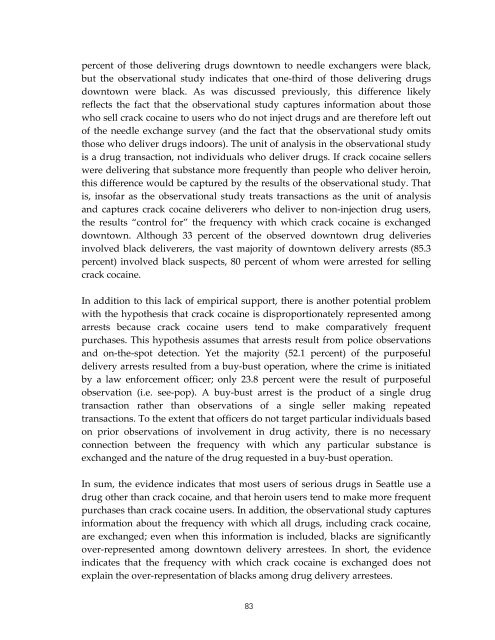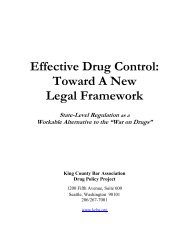RACE AND THE ENFORCEMENT OF DRUG DELIVERY LAWS IN ...
RACE AND THE ENFORCEMENT OF DRUG DELIVERY LAWS IN ...
RACE AND THE ENFORCEMENT OF DRUG DELIVERY LAWS IN ...
Create successful ePaper yourself
Turn your PDF publications into a flip-book with our unique Google optimized e-Paper software.
percent of those delivering drugs downtown to needle exchangers were black,<br />
but the observational study indicates that one-third of those delivering drugs<br />
downtown were black. As was discussed previously, this difference likely<br />
reflects the fact that the observational study captures information about those<br />
who sell crack cocaine to users who do not inject drugs and are therefore left out<br />
of the needle exchange survey (and the fact that the observational study omits<br />
those who deliver drugs indoors). The unit of analysis in the observational study<br />
is a drug transaction, not individuals who deliver drugs. If crack cocaine sellers<br />
were delivering that substance more frequently than people who deliver heroin,<br />
this difference would be captured by the results of the observational study. That<br />
is, insofar as the observational study treats transactions as the unit of analysis<br />
and captures crack cocaine deliverers who deliver to non-injection drug users,<br />
the results “control for” the frequency with which crack cocaine is exchanged<br />
downtown. Although 33 percent of the observed downtown drug deliveries<br />
involved black deliverers, the vast majority of downtown delivery arrests (85.3<br />
percent) involved black suspects, 80 percent of whom were arrested for selling<br />
crack cocaine.<br />
In addition to this lack of empirical support, there is another potential problem<br />
with the hypothesis that crack cocaine is disproportionately represented among<br />
arrests because crack cocaine users tend to make comparatively frequent<br />
purchases. This hypothesis assumes that arrests result from police observations<br />
and on-the-spot detection. Yet the majority (52.1 percent) of the purposeful<br />
delivery arrests resulted from a buy-bust operation, where the crime is initiated<br />
by a law enforcement officer; only 23.8 percent were the result of purposeful<br />
observation (i.e. see-pop). A buy-bust arrest is the product of a single drug<br />
transaction rather than observations of a single seller making repeated<br />
transactions. To the extent that officers do not target particular individuals based<br />
on prior observations of involvement in drug activity, there is no necessary<br />
connection between the frequency with which any particular substance is<br />
exchanged and the nature of the drug requested in a buy-bust operation.<br />
In sum, the evidence indicates that most users of serious drugs in Seattle use a<br />
drug other than crack cocaine, and that heroin users tend to make more frequent<br />
purchases than crack cocaine users. In addition, the observational study captures<br />
information about the frequency with which all drugs, including crack cocaine,<br />
are exchanged; even when this information is included, blacks are significantly<br />
over-represented among downtown delivery arrestees. In short, the evidence<br />
indicates that the frequency with which crack cocaine is exchanged does not<br />
explain the over-representation of blacks among drug delivery arrestees.<br />
83

















